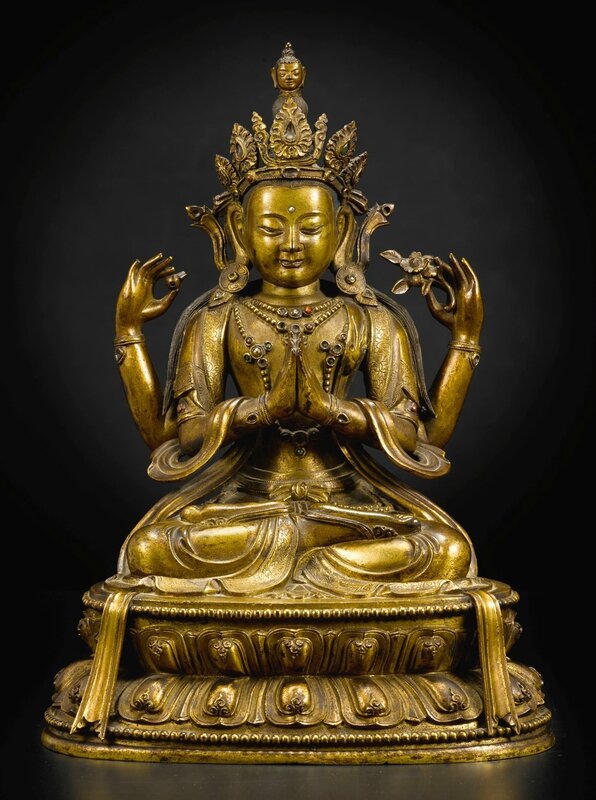A rare and finely cast gilt-bronze figure of Shadakshari Avalokiteshvara, Qing dynasty, Kangxi period (1662-1722)
Lot 136. A rare and finely cast gilt-bronze figure of Shadakshari Avalokiteshvara, Qing dynasty, Kangxi period (1662-1722). Estimate GBP 80,000 - GBP 120,000 (USD 99,680 - USD 149,520). Photo Sotheby's.
the figure seated in dhyanasana on a double lotus base, the principle hands in namaskaramudra, the secondary hands holding a flower and a bhodi bead, wearing a patterned shawl, flowing dhoti and a billowing scarf around his shoulders and arms falling to the base, the face with a peaceful, downcast expression framed by a pair of large studded circular earrings and a five-pointed diadem securing the hair swept in a top knot surmounted by the head of Amitabha, the bare torso adorned with inlaid beaded jewellery; 26.8 cm, 10 1/2 in.
Notes: Shadakshari-Lokeshvara is the four-armed manifestation of the great bodhisattva Avalokiteshvara and is often regarded as the patron deity of Tibet: the Dalai Lamas are deemed to be earthly incarnations of the bodhisattva. This form of Avalokiteshvara is popular with the Gelukpa order of Tibetan Buddhism that was favoured by the Qing court. The deity’s principal hands are held before the heart in the anjalimudra of respectful salutation, with the two outer hands holding the bhodi bead from a rosary representing enlightenment, and the lotus flower of purity. Amitabha emerges from the hair as a symbol of Avalokiteshvara’s spiritual lineage and the wisdom of all Buddhas. Shadakshari-Lokeshvara wears the flayed skin of a mythological deer (krishnasara) draped over the left shoulder as a symbol of benevolence (maitri): the hind legs of the deer can be seen emerging from beneath the shawl covering the shoulders at the back of the bodhisattva. The worship of Shadakshari-Lokeshvara dates back to at least the eleventh century in eastern India: an eleventh century Pala period (ca 750-ca 1200) brass statue of the deity is now in the Jokhang monastery collection, Lhasa, see Ulrich von Schroeder, Buddhist Sculptures in Tibet, Hong Kong, 2001, Vol. I, p. 272, pl. 88A
This rare early Qing period statue of Shadakshari-Lokeshvara bears close resemblance to a Kangxi gilt copper alloy figure of Amitayus in the Qing Court Collection, see The Complete Collection of Treasures of the Palace Museum: Buddhist Statues of Tibet, Hong Kong, 2003, p. 238, cat. no. 227: cf. the scarf ends emerging from beneath the legs and hanging over the front of the lotus base, the large drop-shaped jewel settings in the crown and the jewel settings in the ends of the crown ties so typical of Kangxi works, the engraved textile pattern of the robe hems, the downcast eyes and meditative countenance, and the long straight hair tresses on the shoulders.
Sotheby's. Important Chinese Art, Londres, 09 nov. 2016, 11:30 AM

/https%3A%2F%2Fprofilepics.canalblog.com%2Fprofilepics%2F1%2F0%2F100183.jpg)
/https%3A%2F%2Fstorage.canalblog.com%2F03%2F02%2F119589%2F96711876_o.jpg)
/https%3A%2F%2Fstorage.canalblog.com%2F11%2F31%2F119589%2F94773502_o.jpg)
/https%3A%2F%2Fstorage.canalblog.com%2F20%2F83%2F119589%2F94772815_o.jpg)
/https%3A%2F%2Fstorage.canalblog.com%2F26%2F72%2F119589%2F75604929_o.jpg)
/https%3A%2F%2Fstorage.canalblog.com%2F59%2F60%2F119589%2F26458628_o.jpg)





/http%3A%2F%2Fstorage.canalblog.com%2F25%2F06%2F119589%2F128889720_o.jpg)
/http%3A%2F%2Fstorage.canalblog.com%2F90%2F95%2F119589%2F127083850_o.jpg)
/http%3A%2F%2Fstorage.canalblog.com%2F11%2F54%2F119589%2F126902803_o.jpg)
/http%3A%2F%2Fstorage.canalblog.com%2F30%2F00%2F119589%2F125933995_o.jpg)